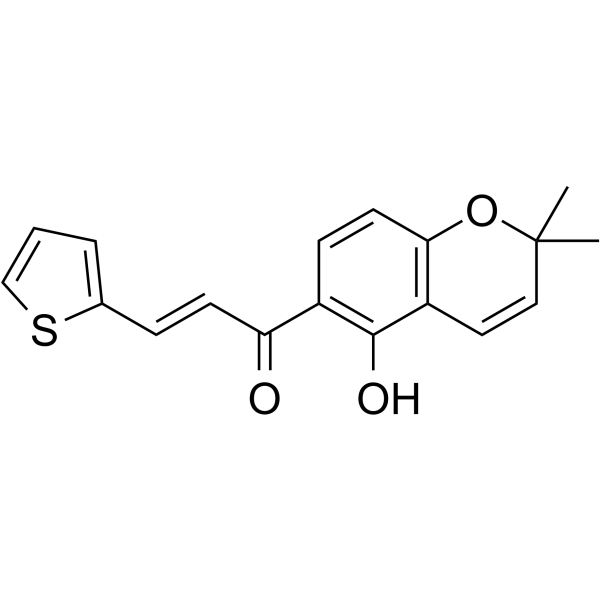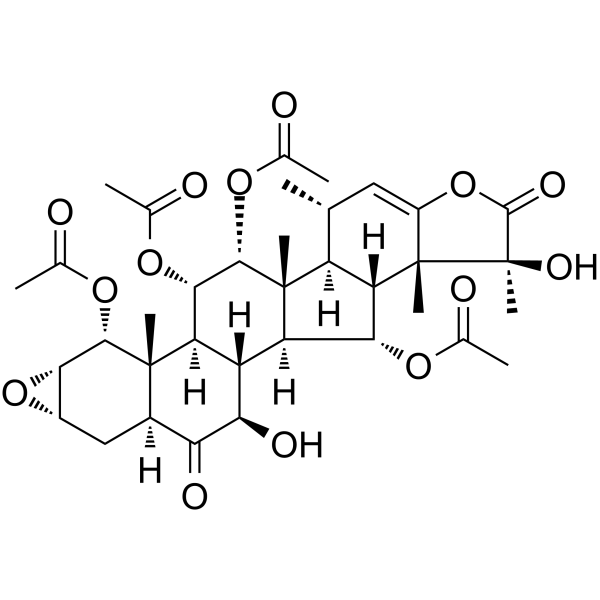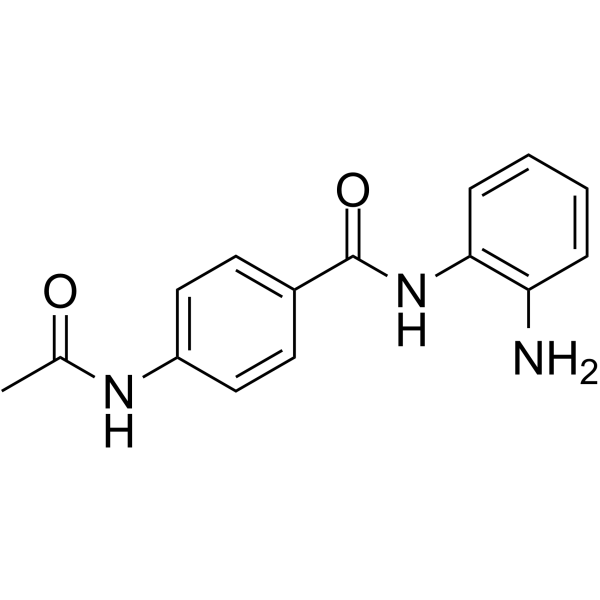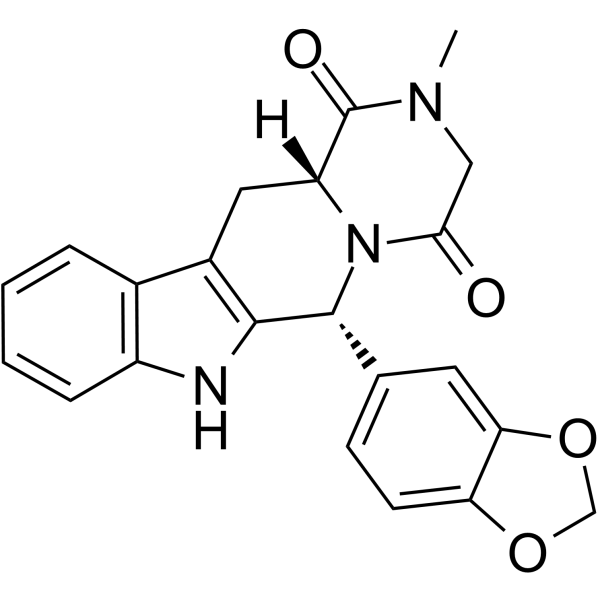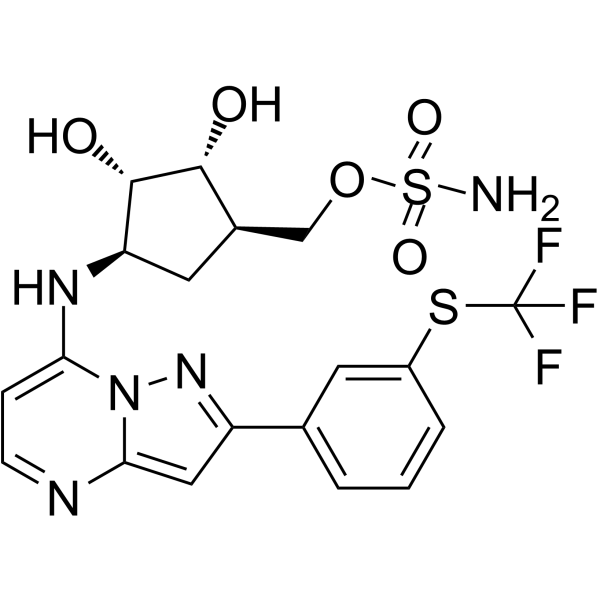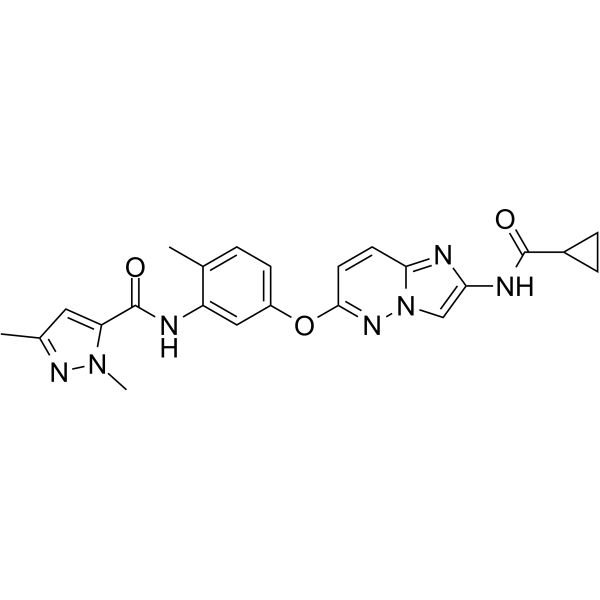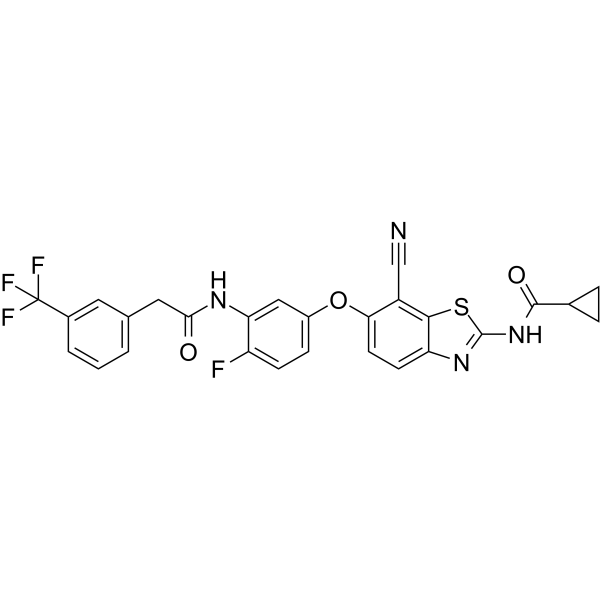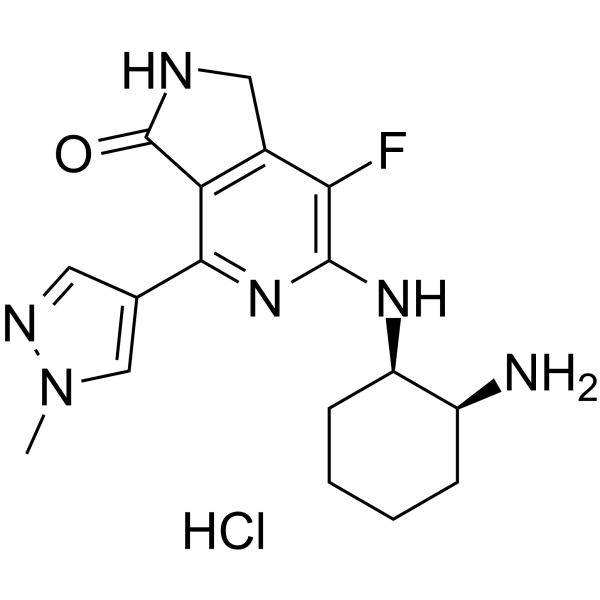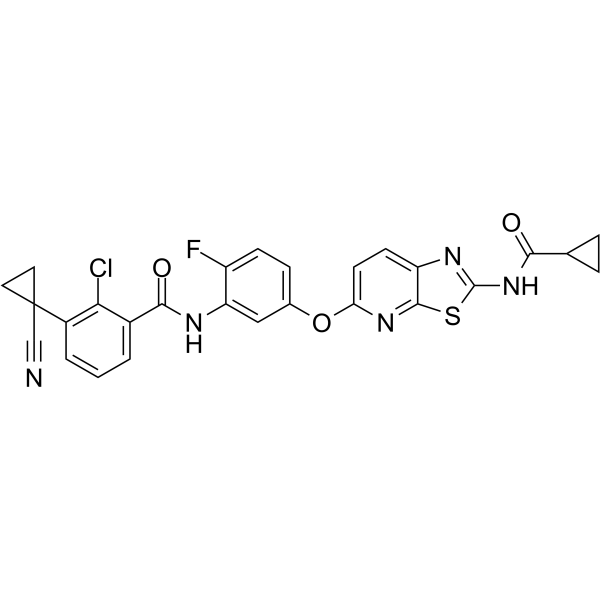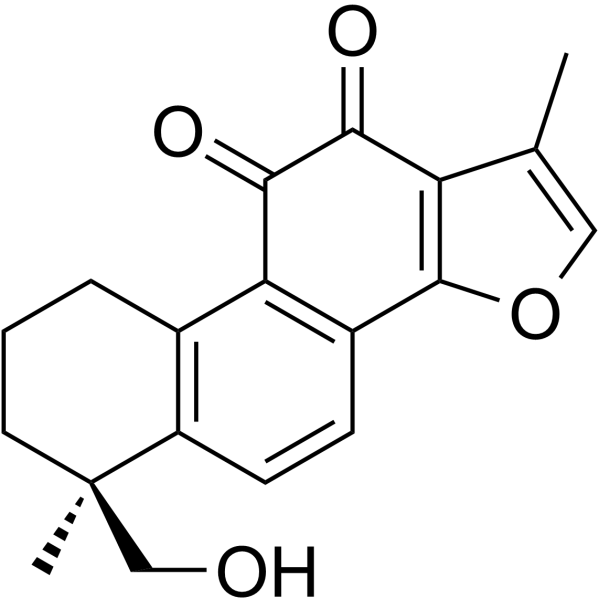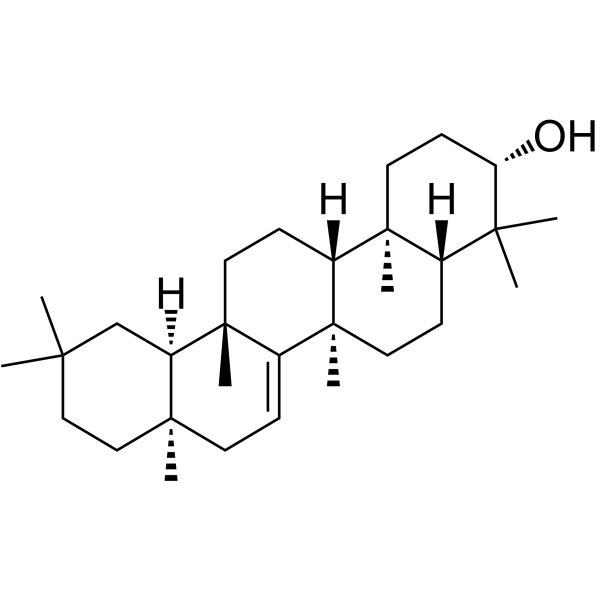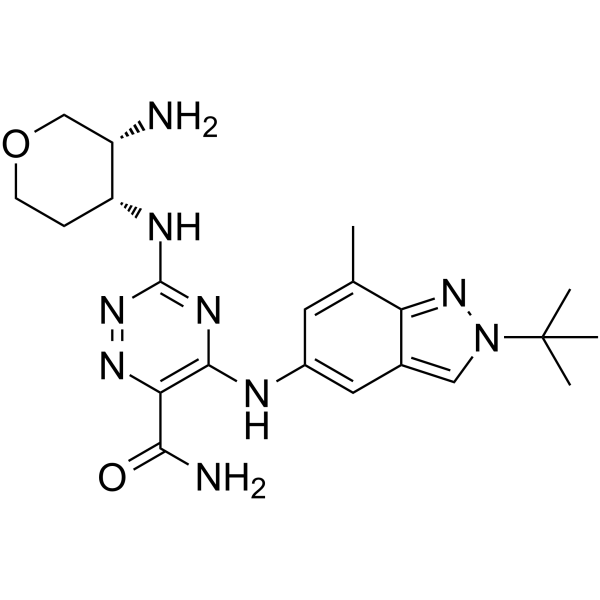|
BP10450
|
SYP-5
|
|
|
|
|
SYP-5 is a novel inhibitor of HIF-1, suppresses tumor cells invasion and angiogenesis.
|
|
BP10114
|
Taccalonolide A
|
|
|
|
|
Taccalonolide A is the first microtubule stabilizing agent to be discovered from a plant since identification of the mechanism of action of paclitaxel and it is the first natural product steroid identified to have these cellular effects,with cytotoxic and antimalarial activities. Taccalonolide A causes G2-M accumulation, Bcl-2 phosphorylation and initiation of apoptosis. Taccalonolide A is effective in vitro against cell lines that overexpress P-glycoprotein (Pgp) and multidrug resistance protein 7 (MRP7), with an IC50 of 622 nM for SK-OV-3 cells.
|
|
BP10151
|
Tacedinaline
|
|
|
|
|
Tacedinaline (N-acetyldinaline) is a novel oral compound with a wide spectrum of antitumor activity in preclinical models. The mechanism of action may involve inhibition of histone deacetylation and cell cycle arrest. Tacedinaline (N-acetyldinaline) is combined with antineoplastic agents commonly used in non-small cell lung cancer cell line management, a marked synergism of action (R=1.8, R=1.5) is observed between Tacedinaline (N-acetyldinaline) (40 μM) and gemcitabine (0.01 μM) at 48 and 72 h of treatment. Tacedinaline (N-acetyldinaline) inhibits mitogen-stimulated blood lymphocyte proliferation with an IC50 value of 3 μM.
|
|
BP10754
|
Tadalafil
|
|
|
|
|
Tadalafil (IC-351) is a PDE5 inhibitor with an IC50 value of 1.8 nM.
|
|
BP10378
|
TAI-1
|
|
|
|
|
TAI-1 is a potent and specific Hec1 inhibitor, which disrupts Hec1-Nek2 protein interaction.
|
|
BP10557
|
TAK-243
|
|
|
|
|
TAK-243 is a small molecule inhibitor of ubiquitin-activating enzyme (UAE ,IC50=1 nM), which blocks ubiquitin conjugation, disrupting monoubiquitin signaling as well as global protein ubiquitination. TAK-243 (MLN7243) induces endoplasmic reticulum (ER) stress, abrogates NF-κB pathway activation and promotes apoptosis,with potential antineoplastic activity.
|
|
BP10009
|
TAK-593
|
|
|
|
|
TAK-593 is a potent VEGFR and PDGFR family inhibitor with IC50s of 3.2, 0.95, 1.1, 4.3 and 13 nM for VEGFR1, VEGFR2, VEGFR3, PDFGRα and PDFGRβ, respectively.
|
|
BP10268
|
TAK-632
|
|
|
|
|
TAK-632 is a potent pan-RAF inhibitor with IC50 of 1.4, 2.4 and 8.3 nM for CRAF, BRAFV600E, BRAFWT, respectively.
|
|
BP10899
|
TAK-659 hydrochloride
|
|
|
|
|
TAK-659 hydrochloride is a highly potent, selective, reversible and orally available dual inhibitor of spleen tyrosine kinase (SYK) and fms related tyrosine kinase 3 (FLT3), with an IC50 of 3.2 nM and 4.6 nM for SYK and FLT3, respectively. TAK-659 hydrochloride induces cell death in tumor cells but not in nontumor cells, and with potential for the treatment of chronic lymphocytic leukemia (CLL).
|
|
BP10153
|
Takeda-6D
|
|
|
|
|
Takeda-6D (compound 6d) is an orally active and potent BRAF/VEGFR2 inhibitor, with IC50 values of 7.0 and 2.2 nM, respectively. Takeda-6D shows antiangiogenesis by suppressing the VEGFR2 pathway in 293/KDR and VEGF-stimulated HUVEC cells.Takeda-6D shows significant suppression of ERK1/2 phosphorylation. Takeda-6D shows antitumor activity.
|
|
BP10136
|
Takinib
|
|
|
|
|
Takinib (EDHS-206) is an orally active and selective TAK1 inhibitor (IC50=9.5 nM), more than 1.5 log more potent than the second and third ranked targets, IRAK4 (120 nM) and IRAK1 (390 nM), respectively. Takinib is an inhibitor of autophosphorylated TAK1 that non-competitively binds within the ATP binding pocket. Takinib induces apoptosis following TNFα stimulation in cell models of rheumatoid arthritis and metastatic breast cancer. Takinib is also a P. falciparum protein kinase 9 (PfPK9) inhibitor (KD(app) of 0.46 μM).
|
|
BP10681
|
Talampanel
|
|
|
|
|
Talampanel (LY300164) is an orally and selective α-amino-3-hydroxy-5-methyl-4-isoxazolepropionate (AMPA) receptor antagonis with anti-seizure activity. Talampanel (IVAX) has neuroprotective effects in rodent stroke models. Talampanel attenuates caspase-3 dependent apoptosis in mouse brain.
|
|
BP10471
|
Tannic acid
|
|
|
|
|
Tannic acid is a novel hERG channel blocker with IC50 of 3.4 μM.
|
|
BP10761
|
Tanshinone IIB
|
|
|
|
|
Tanshinone IIB is a major active constituent of the roots of Salvia miltiorrhiza (Danshen) widely used for the research of stroke and coronary heart disease in Asian countries. Tanshinone IIB has a neuroprotective effect via inhibition of apoptosis.
|
|
BP10092
|
Taraxasterol
|
|
|
|
|
Taraxasterol is a pentacyclic triterpenoid isolated from Taraxacum mongolicum. Taraxasterol has a role as a metabolite and an anti-inflammatory agent.
|
|
BP10332
|
Taraxerol
|
|
|
|
|
Taraxerol is isolated from Taraxacum mongolicum, and has anti-inflammtory and anti-cancer effects. Taraxerol attenuates acute inlammation through inhibition of NF-κB signaling pathway. Taraxerol induces cell apoptosis.
|
|
BP10701
|
Tarloxotinib bromide
|
|
|
|
|
Tarloxotinib bromide (TH-4000) is an irreversible EGFR/HER2 inhibitor.
|
|
BP10518
|
TAS05567
|
|
|
|
|
TAS05567 is a potent, highly selective, ATP-competitive and orally active Syk inhibitor with an IC50 of 0.37 nM. In a panel of 192 kinases, TAS05567 only shows >70% inhibition of Syk and 4 other kinases (FLT3, JAK2, KDR and RET with IC50s of 10 nM, 4.8 nM, 600 nM and 29 nM, respectively). TAS05567 can be used for humoral immune-mediated inflammatory conditions such as autoimmune and allergic diseases.
|
|
BP10720
|
TAS6417
|
|
|
|
|
TAS6417 is an EGFR inhibitor and is an efficacious drug candidate for patients with NSCLC (IC50: ranging from 1.1-8.0 nM).
|
|
BP10128
|
Taurodeoxycholic acid sodium hydrate
|
|
|
|
|
Taurodeoxycholic acid sodium hydrate (Sodium taurodeoxycholate monohydrate), a bile acid, is an amphiphilic surfactant molecule synthesized from cholesterol in the liver. Taurodeoxycholic acid sodium hydrate activates the S1PR2 pathway in addition to the TGR5 pathway.
|
